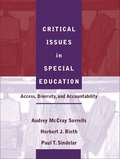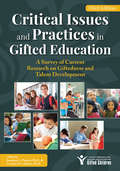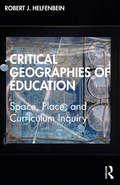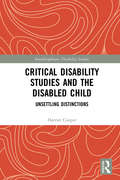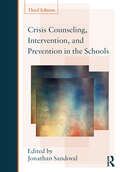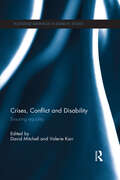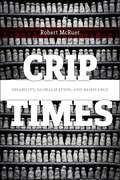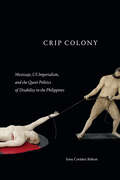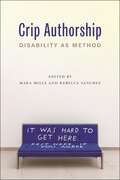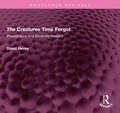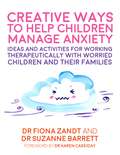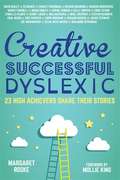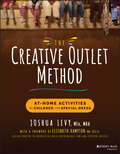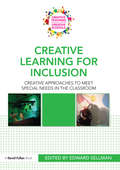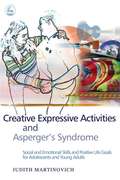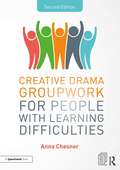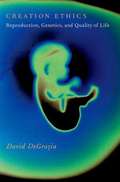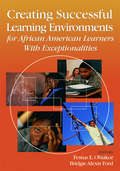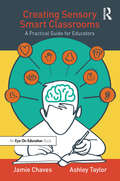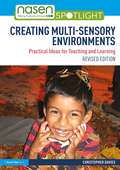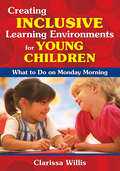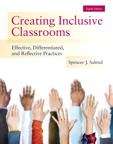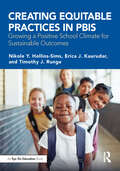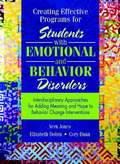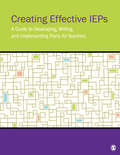- Table View
- List View
Critical Issues in Special Education: Access, Diversity, and Accountability
by Audrey Mccray Sorrells Herbert J. Rieth Paul T. SindelarThis textbook provides synopses of current issues deemed critical in the field of special education as outlined by the most prolific authors.
Critical Issues and Practices in Gifted Education: A Survey of Current Research on Giftedness and Talent Development
by Ph. D. And Carolyn M. Callahan Jonat PluckerCritical Issues and Practices in Gifted Education is the definitive reference for a summary and evaluation of the literature on giftedness, gifted education, and talent development. This third edition:Presents more than 40 summaries of important topics in the field.Features updates to all topics.Introduces new topics, including neuroscience and the roles of leaders in the field.Dives into the latest research.Explores how the research applies to gifted education and the lives of gifted learners.This book also provides an objective assessment of the available knowledge on each topic, offers guidance in the application of the research, and suggests areas of needed research.
Critical Geographies of Education: Space, Place, and Curriculum Inquiry
by Robert J. HelfenbeinWINNER 2023 Society of Professors of Education Outstanding Book AwardCritical Geographies of Education: Space, Place, and Curriculum Inquiry is an attempt to take space seriously in thinking about school, schooling, and the place of education in larger society. In recent years spatial terms have emerged and proliferated in academic circles, finding application in several disciplines extending beyond formal geography. Critical Geography, a reconceptualization of the field of geography rather than a new discipline itself, has been theoretically considered and practically applied in many other disciplines, mostly represented by what is collectively called social theory (i.e., anthropology, sociology, cultural studies, political science, and literature). The goal of this volume is to explore how the application of the ideas and practices of Critical Geography to educational theory in general and curriculum theorizing in specific might point to new trajectories for analysis and inquiry. This volume provides a grounding introduction to the field of Critical Geography, making connections to the significant implications it has for education, and by providing illustrations of its application to specific educational situations (i.e., schools, classrooms, and communities). Presented as an intellectual geography that traces how spatial analysis can be useful in curriculum theorizing, social foundations of education, and educational research, the book surveys a range of issues including social justice and racial equity in schools, educational reform, internationalization of the curriculum, and how schools are placed within the larger social fabric.
Critical Disability Studies and the Disabled Child: Unsettling Distinctions (Interdisciplinary Disability Studies)
by Harriet CooperThis book examines the relationship between contemporary cultural representations of disabled children on the one hand, and disability as a personal experience of internalised oppression on the other. In focalising this debate through an exploration of the politically and emotionally charged figure of the disabled child, Harriet Cooper raises questions both about what it means to ‘speak for’ the other and about what resistance means when one is unknowingly invested in one’s own abjection. Drawing on both the author’s personal experience of growing up with a physical impairment and on a range of critical theories and cultural objects – from Frances Hodgson Burnett’s novel The Secret Garden to Judith Butler’s work on injurious speech – the book theorises the making of disabled and ‘rehabilitated’ subjectivities. With a conceptual framework informed by both psychoanalysis and critical disability studies, it investigates the ways in which cultural anxieties about disability come to be embodied and lived by the disabled child. Posing new questions for disability studies and for identity politics about the relationships between lived experiences, cultural representations and dominant discourses – and demonstrating a new approach to the concept of ‘internalised oppression’ – this book will be of interest to scholars and students of disability studies, medical humanities, sociology and psychosocial studies, as well as to those with an interest in identity politics more generally.
Crisis Counseling, Intervention and Prevention in the Schools (Consultation, Supervision, and Professional Learning in School Psychology Series)
by Jonathan SandovalSince the first edition was published in 1988, the role of crisis intervention and prevention has become central to mental health professionals working in the schools. Disasters such as hurricane Katrina, terrorist attacks both in this country and around the world, and various school shootings have greatly increased school crisis research and policy development. This book is designed for an introductory graduate course taken by students in school psychology, school counseling, and school social work. Section I provides a crisis response overview, section II deals with crises for children and adolescents and section III covers crises that manifest in adolescence. Discussions of the 16 most prevalent types of crises are covered in sections II and III and include their characteristics, causes, interventions, and preventive programs. All chapters will be updated, six heavily revised or totally rewritten by new authors, and two new chapters (chapters 8 & 19) have been added.
Crises, Conflict and Disability: Ensuring Equality (Routledge Advances in Disability Studies)
by David Mitchell Valerie KarrPeople with disabilities are among the most adversely affected during conflict situations or when natural disasters strike. They experience higher mortality rates, have fewer available resources and less access to help, especially in refugee camps, as well as in post-disaster environments. Already subject to severe discrimination in many societies, people with disabilities are often overlooked during emergency evacuation, relief, recovery and rebuilding efforts. Countries party to the UN Convention on the Rights of Persons with Disabilities must take all necessary measures to ensure the protection and safety of people with disabilities during situations of armed conflict, humanitarian emergencies, and natural disasters. Such aid should be designed to support preparedness, response, recovery and rebuilding. This book includes perspectives from around the globe and explores the implications at the policy, programme, and personal level, discussing issues such as: How can national laws, policies, and regulations provide guidance, methods and strategies to integrate and coordinate inclusive emergency management? What should people with disabilities know in order to be prepared for emergency situations? What lessons have we learned from past experiences? What are the current shortfalls (physical and cultural) that put people with disabilities at risk during emergencies and what can be done to improve these situations (e.g. through new technologies and disaster planning)? How does disability affect people’s experiences as refugees and other displaced situations; what programmes and best practices are in place to protect and promote their rights during their period of displacement? How must disabled people with disabilities be factored in to the resettlement and rebuilding process; does an opportunity for ensuring universal access exist in the rebuilding process? What is the impact of disasters and conflicts on such special populations as disabled women, disabled children, and those with intellectual disabilities? Spotlighting a pressing issue that has long been neglected in emergency planning fields, this innovative book discusses how to meet the needs of people with disabilities in crises and conflict situations. It is an important reference for all those working in or researching disability and inclusion, and emergency and disaster management, both in developed and developing countries.
Crip Times: Disability, Globalization, and Resistance (Crip #1)
by Robert McRuerContends that disability is a central but misunderstood element of global austerity politics. Broadly attentive to the political and economic shifts of the last several decades, Robert McRuer asks how disability activists, artists and social movements generate change and resist the dominant forms of globalization in an age of austerity, or “crip times.” Throughout Crip Times, McRuer considers how transnational queer disability theory and culture—activism, blogs, art, photography, literature, and performance—provide important and generative sites for both contesting austerity politics and imagining alternatives. The book engages various cultural flashpoints, including the spectacle surrounding the London 2012 Olympic and Paralympic Games; the murder trial of South African Paralympian Oscar Pistorius; the photography of Brazilian artist Livia Radwanski which documents the gentrification of Colonia Roma in Mexico City; the defiance of Chilean students demanding a free and accessible education for all; the sculpture and performance of UK artist Liz Crow; and the problematic rhetoric of “aspiration” dependent upon both able-bodied and disabled figurations that emerged in Thatcher’s England. Crip Times asserts that disabled people themselves are demanding that disability be central to our understanding of political economy and uneven development and suggests that, in some locations, their demand for disability justice is starting to register. Ultimately, McRuer argues that a politics of austerity will always generate the compulsion to fortify borders and to separate a narrowly defined “us” in need of protection from “them.”
Crip Colony: Mestizaje, US Imperialism, and the Queer Politics of Disability in the Philippines
by Sony Coráñez BoltonIn Crip Colony, Sony Coráñez Bolton examines the racial politics of disability, mestizaje, and sexuality in the Philippines. Drawing on literature, poetry, colonial records, political essays, travel narratives, and visual culture, Coráñez Bolton traces how disability politics colluded with notions of Philippine mestizaje. He demonstrates that Filipino mestizo writers in the late nineteenth and early twentieth centuries used mestizaje as a racial ideology of ability that marked Indigenous inhabitants of the Philippines as lacking in civilization and in need of uplift and rehabilitation. Heteronormative, able-bodied, and able-minded mixed-race Filipinos offered a model and path for assimilation into the US empire. In this way, mestizaje allowed for supposedly superior mixed-race subjects to govern the archipelago in collusion with American imperialism. By bringing disability studies together with studies of colonialism and queer-of-color critique, Coráñez Bolton extends theorizations of mestizaje beyond the United States and Latin America while considering how Filipinx and Filipinx American thought fundamentally enhances understandings of the colonial body and the racial histories of disability.
Crip Authorship: Disability as Method
by Mara Mills and Rebecca SanchezAn expansive volume presenting crip approaches to writing, research, and publishingCrip Authorship: Disability as Method is an expansive volume presenting the multidisciplinary methods brought into being by disability studies and activism. Mara Mills and Rebecca Sanchez have convened leading scholars, artists, and activists to explore the ways disability shapes authorship, transforming cultural production, aesthetics, and media.Starting from the premise that disability is plural and authorship spans composition, affect, and publishing, this collection of thirty-five compact essays asks how knowledge about disability is produced and shared in disability studies. Disability alters, generates, and dismantles method. Crip authorship takes place within and beyond the commodity version of authorship, in books, on social media, and in creative works that will never be published. The chapters draw on the expertise of international researchers and activists in the humanities, social sciences, education, arts, and design. Across five sections—Writing, Research, Genre/Form, Publishing, Media—contributors consider disability as method for creative work: practices of writing and other forms of composition; research methods and collaboration; crip aesthetics; media formats and hacks; and the capital, access, legal standing, and care networks required to publish. Designed to be accessible and engaging for students, Crip Authorship also provides theoretically sophisticated arguments in a condensed form that will make the text a key resource for disability studies scholars. Essays include Mel Y Chen on the temporality of writing with chronic illness; Remi Yergeau on perseveration; La Marr Jurelle Bruce on mad Black writing; Alison Kafer on the reliance of the manifesto genre on disability; Jaipreet Virdi on public scholarship for disability justice; Ellen Samuels on the importance of disability and illness to autotheory; Xuan Thuy Nguyen on decolonial research methods for disability studies; Emily Lim Rogers on virtual ethnography; Cameron Awkward-Rich on depression and trans reading methods; Robert McRuer on crip theory in translation; Kelsie Acton on plain language writing; and Georgina Kleege on description as an access and aesthetic technique.
The Creatures Time Forgot: Photography and Disability Imagery (Routledge Revivals)
by David HeveyFirst published in 1992, The Creatures Time Forgot examines the representation of disabled people – in advertising, particularly that produced by disability charities, and in the work of photographers such as Diane Arbus and Gary Winogrand. He shows how such images construct disabled people as ‘creatures,’ the tragic-but-brave objects of photographic gaze, or as the ‘’appy ‘andicapped’ of ‘positive imagery’ advertising. As a disabled photographer and writer, David Hevey has been a pioneer in challenging such visual representations of disabled people. His work advocates a move away from medical, charity or impairment-fixated imagery towards a visual equivalent of ‘Rights not Charity’. The book outlines David Hevey’s own photographic practice and includes wide-ranging selections from his work to create a visual form which reflects the new social presence of disabled people. This book will be of interest to students of media studies, cultural studies, and disability studies.
Creative Ways to Help Children Manage Anxiety: Ideas and Activities for Working Therapeutically with Worried Children and Their Families
by Fiona Zandt Suzanne BarrettThis book sets out therapeutic activities to help children aged 4-12 years and their families to better understand and manage anxiety. It explains how to work with anxious children, providing a framework for assessment and therapy that draws on CBT, ACT and narrative therapy approaches. Lots of practical tips for therapists are included and important developmental considerations are discussed, including adapting therapy for children with developmental difficulties, and working with families and schools.Over 50 playful therapeutic activities are included, which have been developed through the authors' extensive work with children, giving children an arsenal of coping strategies. They focus on key areas such as understanding anxiety, managing anxious thoughts, and building resilience and use readily available, inexpensive materials and downloadable templates which are provided in the book. This is the perfect tool for therapists looking for playful and purposeful ways to work with children with anxiety.
Creative, Successful, Dyslexic: 23 High Achievers Share Their Stories
by Kelly Hoppen Mbe Zelda West-Meads Sir Richard Branson Sophie Conran Lynda La Cbe Margaret Rooke Theo Paphitis Zoe Wanamaker Cbe Sir Jackie Obe David Bailey Cbe Steven Naismith Paul Nixon Darcey Bussell Cbe Brian Conley Nigel Mccrery Ed Baines Meg Mathews Benjamin Zephaniah Mollie King Chris Robshaw Eddie Izzard Marcus Brigstocke Charley Boorman Kenny Logan Richard Rogers23 very well-known people from the arts, sport, and business worlds talk about how dyslexia affected their childhood, how they were able to overcome the challenges and use the special strengths of dyslexia to achieve great success in adulthood. Darcey Bussell CBE, Eddie Izzard, Sir Richard Branson, Meg Mathews, Zoe Wanamaker CBE, Richard Rogers, Benjamin Zephaniah, Steven Naismith, Lynda La Plante CBE, Sir Jackie Stewart OBE, Sophie Conran and others share their stories, and their advice. All reveal the enormous difficulties they faced, the strength required to overcome them, the crucial importance of adult support, and how `the different way the brain is wired' in dyslexia has enabled them to see something different in the world and to use their creativity in an exceptional way. They talk about `thinking sideways', and the ability to look at a bigger picture, the often strong visual strength, and the ability to listen, and to grasp simplicity where other people see only complexity. They also talk about how dyslexia continues to challenge them, and the ways they have found to work around this. An introduction, and final section that includes practical information about dyslexia, are written with the support of Dyslexia Action, and a percentage of profit from the book is donated to Dyslexia Action. The book will be essential reading for teachers and other professionals, and for families affected by dyslexia, and inspirational for people with dyslexia.
The Creative Outlet Method: At-Home Activities for Children with Special Needs
by Joshua LevyA practical guide for parents and special educators to help enrich the lives of children with special needs In The Creative Outlet Method Book of Creativity: At-Home Activities for Children with Special Needs, certified special education educator Joshua Levy delivers practical and effective resources for conducting over 30 enriching theater arts and improvisational activities. The included exercises will allow children with disabilities to demonstrate creativity, increase self-confidence, and build social skills. Special needs children will benefit from the innovative approaches included in The Creative Outlet Method and experience creative energy from the comfort of home. The book also offers: Opportunities for children with special needs to achieve their academic, social, and behavioral goals Activities that enrich the lives of special needs students, their parents, and other caregivers A 10-step framework to improving the learning outcomes for children with special needs The Creative Outlet Method Book of Creativity is an indispensable resource for the parents and caregivers of special needs children, special education teachers, administrators, and therapists. It's also a must-read for K-12 general educators looking for ways to better engage with their special needs students.
Creative Learning for Inclusion: Creative approaches to meet special needs in the classroom (Creative Teaching/Creative Schools)
by Edward SellmanIntroducing creativity to the classroom is a concern for teachers, governments and future employers around the world, and there has been a drive to make experiences at school more exciting, relevant, challenging and dynamic for all young people, ensuring they leave education able to contribute to the global creative economy. Creative Learning to Meet Special Needs shows teachers how to use creativity in the curriculum for key stages 2 and 3 to support the learning of pupils with special educational needs in a way which effectively engages them and leaves a lasting impact on their school experiences and later lives. Describing the different ways in which a creative approach can help pupils with SEN access the curriculum, with activities and practical materials for teachers, this book will explain: why creativity is central to making the curriculum accessible how to use personalised learning with pupils with SEN how to promote achievements and motivation through creative experiences how the curriculum can be extended and represented in innovative ways for pupils with SEN how to use interactive methods of teaching and alternative methods of communication. Providing case studies and examples of the ways in which teachers have delivered the curriculum creatively to pupils with special educational needs, this book is an invaluable guide for all those involved in teaching and engaging young people with special needs.
Creative Expressive Activities and Asperger's Syndrome: Social and Emotional Skills and Positive Life Goals for Adolescents and Young Adults
by Judith MartinovichIndividuals with Asperger's Syndrome (AS) benefit from a positive, affirming support of their individuality. This forward-looking book focuses on building individual strengths and resilience, rather than modifying perceived weaknesses, through individualized therapy within a group context. Integrating psychological and educational theory with a variety of creative therapies, Judith Martinovich combines activities such as art making, drama, music, puppetry, yoga and photography with conventional cognitive behavioral interventions to support individuals with AS. The different activities complement and reinforce each other and are designed to address specific traits of the autism spectrum to aid skills development. Although created primarily for use with adolescents and young adults, the practical and versatile activities can be adapted for different age and skill levels, objectives and settings. Informed by contemporary research, they meet the objectives of a framework of principles drawn from Positive Psychology and Social and Emotional Learning. Creative Expressive Activities and Asperger's Syndrome is a comprehensive resource for parents as well as teachers, social workers, psychologists and arts therapists who wish to link therapeutic goals with creative activities for people with or without Asperger's Syndrome.
Creative Drama Groupwork for People with Learning Difficulties
by Anna ChesnerThe revised second edition of this practical manual is filled with easy-to-follow exercises and activities designed to facilitate creative drama sessions for people with learning difficulties. The activities in this book bring together music, theatre, movement and storytelling to not only develop fun and engaging group sessions, but to build confidence, increase self-esteem, and develop social and emotional awareness in group members. Highly sensitive to the range of learning needs and physical abilities of group members, the activities have been created to be engaging for a broad range of individuals regardless of age and ability, and can be adapted for use in a multitude of sectors such as education, psychology and speech and language therapy. Key features of this edition include: • New chapters exploring mindfulness, and the importance of reflection • Fully photocopiable resources including a session notes template to evaluate the impact of the creative drama group and collect useful data for the writing of reports • Activities organised around key elements of creative drama, such as sensory work, life skills role-play, improvisation and de-roling With its wealth of guidance, practical and adaptable activities and easy-to- follow structure, this is an invaluable resource for anybody leading or supporting children, young people and adults in creative drama.
Creation Ethics: Reproduction, Genetics, and Quality of Life
by David DegraziaThe ethics of creating-or declining to create-human beings has been addressed in several contexts: debates over abortion and embryo research; literature on "self-creation"; and discussions of procreative rights and responsibilities, genetic engineering, and future generations. Here, for the first time, is a sustained, scholarly analysis of all of these issues-a discussion combining breadth of topics with philosophical depth, imagination with current scientific understanding, argumentative rigor with accessibility. The overarching aim ofCreation Ethicsis to illuminate a broad array of issues connected with reproduction and genetics, through the lens of moral philosophy. With novel frameworks for understanding prenatal moral status and human identity, and exceptional fairness to those holding different views, David DeGrazia sheds new light on the ethics of abortion and embryo research, genetic enhancement and prenatal genetic interventions, procreation and parenting, and decisions that affect the quality of life of future generations. Along the way, he helpfully introduces personal identity theory and value theory as well as such complex topics as moral status, wrongful life, and the "nonidentity problem. " The results include a subjective account of human well-being, a standard for responsible procreation and parenting, and a theoretical bridge between consequentialist and nonconsequentialist ethical theories. The upshot is a synoptic, mostly liberal vision of the ethics of creating human beings. "This is a valuable book on a fascinating topic, written by a major figure in the field. The topic of the ethics of creating people is both practically urgent, as new technologies develop for shaping human offspring, and also of great theoretical importance for ethics and meta-ethics because it engages the deepest issues, including those of moral status, the nature of justice, and identity. DeGrazia has already proved to be an important force in shaping the debate regarding these issues. Anyone writing on this topic will have to address this book head-on. The style is remarkably lucid and almost jargon-free. Given that the book is filled with complex, sustained argumentation, this is quite an accomplishment. This book will be of interest to legal scholars, philosophers working in normative ethics, meta-ethics, and bioethics, and public policy scholars. " - Allen Buchanan, James B. Duke Professor of Philosophy, Duke University
Creating Successful Learning Environments for African American Learners With Exceptionalities
by Dr Festus E. Obiakor Dr Bridgie Alexis FordIn this groundbreaking book, more than 25 leading scholars and practitioners provide concrete solutions for maximizing African American students' achievement.
Creating Sensory Smart Classrooms: A Practical Guide for Educators
by Jamie Chaves Ashley TaylorCreating Sensory Smart Classrooms introduces educators to the foundations of sensory processing and offers tools to meet the wide variety of sensory needs in each classroom. This comprehensive handbook helps readers understand the neurobiology behind sensory processing and regulation issues, recognize when a student is over- or under-stimulated, and integrate different sensory inputs into the school environment. Practical and accessible chapters foster an understanding of how sensory processing influences behaviors in the classroom and how protective relationships, combined with sensory strategies, positively influence students' regulation for improved learning outcomes. Packed with useful examples, this is essential reading for teachers looking to develop the knowledge and skills they need to design sensory smart environments that support ALL learners.
Creating Multi-sensory Environments: Practical Ideas for Teaching and Learning (nasen spotlight)
by Christopher DaviesThe revised edition of this highly practical guide to creating and using multi-sensory environments is packed full of ideas for low-cost, easy to assemble multi-sensory environments suitable for children of varying ages and abilities. Each creative learning environment is designed to be constructed in a classroom or school hall, encouraging creative thinking and learning, and development of social and emotional skills. Each environment idea is accompanied by suggestions for use for children with special educational needs. Key features of the revised edition include: Ideas for creating sensory experiences that stimulate all the sensory channels – auditory, visual, kinaesthetic, olfactory and gustatory Suggestions for extension or differentiation depending on student capability or time available A summary of the theory and background to multi-sensory learning, to allow you to adapt the suggested scenarios according to the needs of individual learners Although these activities will be of particular value for children with special educational needs or sensory impairments, they are more broadly designed to provide stimulating learning environments, as promoted in the themes and principles of the Early Years Foundation Stage Guidance. This is an invaluable resource for teachers and other professionals in education.
Creating Inclusive Learning Environments for Young Children: What to Do on Monday Morning
by Dr Clarissa WillisThis book provides information on common disabilities and practical strategies for creating inclusive environments and building student relationships.
Creating Inclusive Classrooms: Effective, Differentiated, and Reflective Practices (Eighth Edition)
by Spencer J. SalendCreating effective inclusive classrooms means understanding the role of education in a democratic society and federal legislation, as well as aligning your instruction with national and state standards. But the practical, up-to-date and digital eighth edition of Creating Inclusive Classrooms: Effective, Differentiated and Reflective Practices recognizes that it means more than that. It means using current research related to effective practices in curriculum, instruction, technology, assessment, classroom management, collaboration, and family involvement to foster the learning of all of your students. It means being an evidence-based and reflective educator who continually collects and analyzes evidence to document and enhance the effectiveness of your professional practices, and who thinks critically about your own values and beliefs so you can better differentiate your instruction and promote the learning of all of your students. It means being sensitive and responsive to diversity and individual differences, and collaborating with your students and their families and other educators to create the most successful educational experience for all of your students.
Creating Equitable Practices in PBIS: Growing a Positive School Climate for Sustainable Outcomes
by Nikole Y. Hollins-Sims Erica J. Kaurudar Timothy J. RungeThis go-to resource guides educators on how to incorporate equitable practices in a PBIS framework. The authors cover core concepts including school-wide positive behavioral interventions and supports (SWPBIS) and multi-tiered system of supports (MTSS), define equity, and present methods for enhancing implementation practices through an equity mindset. Chapters also include an analysis of team structures and the evaluation of baseline data sources, walking readers through how to incorporate effective practices to support an integrated MTSS framework and produce sustainable outcomes. This book is ideal for educators, behavioral specialists, and administrators who wish to promote a positive school climate and purposeful educational relationships.
Creating Effective Programs for Students with Emotional and Behavior Disorders
by Cory Dunn Elizabeth Dohrn Vern JonesThis exiting new book provides special educators, school psychologists, and others responsible for programs for students serving students with EBD with specific methods, supported by sound research and proven by practice, for developing or improving services to this student population. While several current books provide excellent discussions concerning characteristics of students with EBD and describe some methods that have been effective in helping these students improve their behavior, this is the only book to provide a thorough, comprehensive examination of concepts and strategies needed to effectively develop and implement a program for this student population. special educators, school psychologists, therapists.
Creating Effective IEPs: A Guide to Developing, Writing, and Implementing Plans for Teachers
by Nancy BurtonCreating Effective IEPs: A Guide to Developing, Writing, and Implementing Plans for Teachers is a brief primer on Individualized Education Plans that has been developed as a custom supplement for textbooks in Introduction to Education, Introduction to Inclusion, and SPED Teaching Strategies. The Individualized Education Plan is one of the most important parts of an exceptional child’s education – it is the document shared among teachers, administrators, paraprofessionals and parents that outlines the accommodations and strategies for educating a child with special needs. An effective IEP must be well-thought out, clearly defined, and embraced by all parties involved in a child’s education, including administrators and parents. This primer provides practical instruction for writing IEPs, leading IEP meetings, and implementing the goals in a classroom setting. Practical exercises and real-world appendices help make the material accessible for students preparing to enter the workforce.
